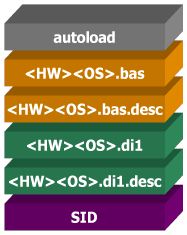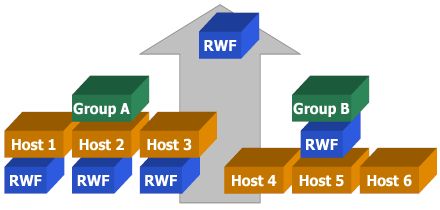 This
is the
The Rembo Wizard's file
name diagram, referred as RWF
This
is the
The Rembo Wizard's file
name diagram, referred as RWF .
. This
is the
The Rembo Wizard's file
name diagram, referred as RWF
This
is the
The Rembo Wizard's file
name diagram, referred as RWF .
.
autoload is the file containing configuration information.
<HW><OS>.bas is the operating system installation's base image, desc being a text file containing a description. If the base image is very large, the file may be splitted into several files on the Rembo Server, depending of its settings.
<HW><OS>.di1 is the first differential image, compared to the base image. There can be three differential images (di1, di2, di3).
SID stores at host level a unique system identifier for Windows NT/2000/XP systems.
BootSector, and some other files may be attributed at host level to systems with unattended and automatic reparation features.
<HW> is a three capital letter identifier chosen for the target
host hardware, while
<OS> is a three capital letter identifier chosen for the target's
operating system.
The Rembo Wizard follows Rembo's host -> group -> global search hierachy when it localize the file positions.

In the above example, Group A of computers is configured each to have their
own, individual back-up scheme. Group can contain different hardware and
operating system configurations.
Note: when using cloning techniques you would create a base image
in the global or in the group level. In the case of the example Group A of
machines you would like to
Group B is configured to produce identical systems (clones) from a grouped
system image.
It is very rare that an host would need
The Rembo Wizard files
from the global level, which is rather a system administrator's repository.
For obvious practical reasons, when looking at the Rembo Server's file system with the Rembo Management Console, the group directories and host directories (based on the MAC address of each host) are presented on the same level.
 This
picture shows how target host's autoload and SID files are located
in the Rembo Server's file system.
This
picture shows how target host's autoload and SID files are located
in the Rembo Server's file system.
 Target
host's base images and differential images are located under hdimages-directory.
It is worthwhile to note that
The Rembo Wizard does not
use subdirectories for each operating system type, although they can be created
by some other Rembo wizards. The operating system type is contained in the
image's file name.
Target
host's base images and differential images are located under hdimages-directory.
It is worthwhile to note that
The Rembo Wizard does not
use subdirectories for each operating system type, although they can be created
by some other Rembo wizards. The operating system type is contained in the
image's file name.